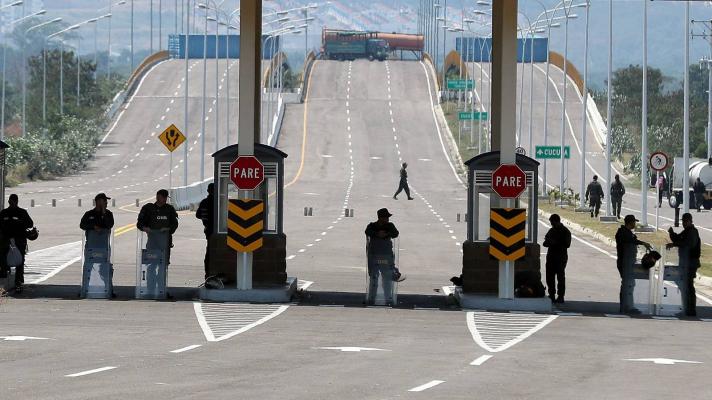More than 2,200 kilometers of border have been shared by Colombia and Venezuela for centuries, when colonial names and statuses were different and the current republics were only dreamed-of entities. After the republics, when we were actually one with Ecuador and Panama, the borders were not determined as national, but as a cultural and administrative departmental landscape.
From 1821 to 1831 the Orinoco and Magdalena rivers were part of the same geopolitical conformation, later divided and conquered by the new imperialisms of the 19th and 20th centuries.
Since then, the name of Colombia is no longer associated with a grand-national project of Bolivarian character but with a factory of criminal economies and policies, because of a relationship of strategic subordination on behalf of its elites to U.S. interests, which results in a restricted autonomy on its side. An important historical research by Renán Vega Cantor has shown that the U.S.-Colombia relationship is marked by imperialist interference, the implementation of counterinsurgency policies and the institutionalization of state terrorism.
If we rigorously apply the conceptual nomenclature used by the anthropologist Rodolfo Quintero, the “culture of conquest” has dominated the Republic of Venezuela with the U.S. always playing a leading role in pulling the strings in Venezuelan deep politics, with the smell of oil in the background. The so-called Washington Consensus at the end of the 20th century had this geostrategic enclave by the neck, which was the territorial, economic and cultural combination of our two countries separated after being born in the 19th century.
With the Bolivarian Revolution’s assumption of power in Venezuela, some of the neighboring country’s dynamics changed towards its borders, which then became enthroned towards a continuous conflict between States, adding to those 2,200 Colombian-Venezuelan kilometers a porosity susceptible to war war laboratories of different types and missions currently in vogue.
What is happening between the state of Apure and the department of Arauca is an expression of that relationship, with Colombia as the state actor whose strategic link depends on the interests and decisions taken by the the United States, used as a pivot of conflict against the Venezuelan state, characterized by its confrontation with the destructive pressures to impose “regime change”.
Thus understanding the historical panorama, it is not bold to affirm that the social and armed conflict in Colombia has been extending its consequences beyond its borders for decades. Just remember the bombing ordered by Juan Manuel Santos when he was Minister of Defense of Álvaro Uribe Vélez in 2008 against a camp of the then mobilized FARC-EP located in Ecuador, an attack not authorized by Rafael Correa and which caused a tri-border crisis that resulted in diplomatic and military tension.
The ongoing U.S. war against Venezuela has multiple resources in Colombia, among them the use of criminal armed groups that govern the departments bordering the Bolivarian Republic in covert operations with different purposes and motives and the abuse of the Colombian state apparatus as political-administrative capital, militarized by the very same gringo military-industrial complex.
With Plan Colombia, which today’s President Joe Biden boasts of having conceived in the Senate, began a process of privatization of the war that drives Plan Colombia and counterinsurgency strategies that promote, according to the conclusions of Vega Cantor’s report,
“The use of mercenaries in the internal conflict of our country, who commit numerous crimes (rapes, murders, torture, disappearances), which enjoy full impunity, by virtue of the agreements between Colombia and the United States. This reinforces the “culture of impunity” that characterizes the Colombian Armed Forces”.
As a result of the social and armed conflict, the paramilitary and drug trafficking industries were able to spread into the heart of Colombian society and the Colombian State and, with it, the level of violence between armed and unarmed insurgent groups against the authorities under U.S. tutelage increased. The quarrels of these actors and factors are being vividly expressed on the southern border of Venezuela, in a dynamic typical of the daily war imposed by the criminal economies derived from the historical Colombian conflict.
For this reason, the role of the Venezuelan State itself in the achievement of peace in Colombia must always be emphasized, and therefore it is confronting the strategic interests of the United States and the Colombian Creole oligarchy.
Venezuela and peace in Colombia
Since Iván Duque has presided over the Casa de Nariño (2018) the government of President Nicolás Maduro has repeatedly urged the Colombian State to comply with the orders dictated by the peace agreements signed between the administration of Juan Manuel Santos and the FARC-EP in 2016. Uribismo has basically denied that there is such a thing as a social and armed conflict of historical and existential dimensions for the region in his country, referring rather to a cowboy story between guerrillas and authorities in which only the rotten Cold War logic imposed by gringo military and intelligence manuals.
In fact, Uribe Velez has been the main guarantor of the war party in Colombia, even when he acknowledged the mediating role of Hugo Chavez in the exchange of prisoners carried out between his government and the FARC-EP in 2007.
With the Bolivarian Revolution in power in Venezuela, the objective of achieving a mediation that would bring about peace agreements between guerrillas and the State was achieved due to the offices of, among others, Venezuelan political representatives, whether in Caracas, Bogota, the 2,200 kilometers of border or Havana. Chávez was always emphatic in wanting to contribute to such a process in the neighboring country without getting involved in its internal affairs. It was achieved, based on a profound slogan: peace in Colombia means peace in Venezuela.
Indeed, for the Bolivarian Revolution, the deepening of the social and armed conflict in Colombia has direct implications on Venezuelan stability, as has been demonstrated multiple times, including the current border conflict in Apure-Arauca. With Uribe’s government in power, there have been the greatest bilateral tensions, as the belligerent attitude of Uribe and his cronies is broadly in line with U.S. “regime change” objectives in Venezuela.
The role of the Bolivarian Government in Colombia’s peace is well documented and the former President Santos even thanked it on several occasions before leaving office. Duque rejects that and is deaf to the new exhortation made by Foreign Minister Jorge Arreaza to go back to what was signed in Havana in 2016.
Among the most immediate and strategic geopolitical interests of the State presided by Nicolás Maduro is peace in Colombia: the logic derives from the fact that the political solution to the conflict would produce a more sovereign autonomy with respect to the strategic dependence of the Colombian State on the interests of the United States and, therefore, there would be less risk of threats by destabilizing actions related to “regime change” plans.
Moreover, in peace lies a potential reality in which there should be no stirring of a fratricidal conflict for imperial interests that are infinitely more petty than any lack of understanding between Colombians and Venezuelans, who are more interested in the social benefits of the absence of collisions than in the experienced consequences of a war. This is a key aspect for which all citizens, no matter if they are of one nationality or the other, must fight for.

